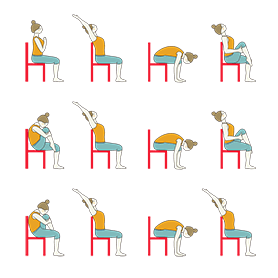Student Works
Table of Contents (please click your choice for quick page navigation; hover over for authors)
- Indulge Your Senses: Chocolate Meditation for College Students
- Aromatherapy 101: Practical Tips for College Students
- Chair Yoga: Workout from the Comfort of Your Seat
- Nutrition 101: Building a Healthier You
- Namaste, College Students: A Guide to the Blissful World of Yoga
- Find Your Zen in the Chaos: A College Student’s Guide to Meditation
- Get Un-Stressed: A College Student’s Guide to Green Tea
Indulge Your Senses: Chocolate Meditation for College Students
Whether you’re breezing through syllabus week or studying for midterms, it’s important to allow yourself the opportunity to be mindful of the small moments. The practice of eating mindfully can reduce stress, promote digestion, and increase satisfaction with food. What’s more, it can be done with any food you’d like. Chocolate Meditation?!! Yes, you read that right! Let’s dive into this unique form of meditation, exploring how to indulge your senses and find calm amid the chaos of college life.
Understanding Chocolate Meditation:
Meditation, in its various forms, involves focusing one’s attention on a particular object or sensation to achieve a state of mindfulness. Chocolate meditation takes this practice a step further by using a piece of chocolate as the focus point. It’s a delightful way to engage your senses and build mindfulness through taste, touch, smell, and even sight.
How to Do Chocolate Meditation:
1. Choose Your Chocolate:
- Select a piece of chocolate that you truly enjoy. Whether it’s dark, milk, or white chocolate, pick one that appeals to your taste buds.
2. Set the Scene:
- Find a quiet, comfortable space where you won’t be disturbed. Turn off distractions like phones or laptops.
3. Prepare for the Meditation:
- Hold the chocolate in your hand and take a few deep breaths to center yourself.
- Observe the chocolate: its texture, color, and aroma. Engage your senses fully before consuming it.
4. Engage Your Senses:
- Feel the chocolate’s texture against your fingers. Notice its shape, weight, and how it melts slightly from your body heat.
- Inhale its scent deeply, allowing the aroma to fill your senses.
- Place the chocolate in your mouth and let it rest on your tongue. Pay attention to the taste, the way it melts, and the flavors that emerge.
5. Stay Present:
- Focus solely on the experience of eating the chocolate. Let thoughts come and go without judgment, gently bringing your attention back to the taste and sensation.
6. Appreciate the Experience:
- After fully experiencing the chocolate, take a moment to appreciate the pleasure it brought and how it made you feel.
Aromatherapy 101: Practical Tips for College Students
Let’s face it, college life is hard. Class, assignments, perhaps part-time jobs—Adding aromatherapy could help your day-to-day relaxation, offering a more holistic approach.
Understanding Aromatherapy:
Aromatherapy is the use of essential oils derived from plants to enhance physical and psychological well-being. Essential oils may contain different substances to stimulate your senses and enhance your mood.
How to Do Aromatherapy:
1. Select Your Essential Oils:
- Begin by choosing essential oils that go along with your needs. The most popular options that most people choose are lavender for relaxation, peppermint for focus, eucalyptus or citrus oils.
-
- Diffusion: You can use an essential oil diffuser, a simple and easy way to disperse the aroma throughout your room or study area.
- Topical Application: Dilute essential oils with a carrier oil (like coconut or jojoba) and apply to pulse points or use in massage.
- Inhalation: Add a few drops to a bowl of hot water and inhale deeply.
3. Create a Relaxing Environment:
- Set the mood by dimming lights, playing calming music, and eliminating distractions.
- Experiment with different combinations of oils to find what works best for you.
Benefits of Aromatherapy for College Students:
- Improved Focus: Certain scents can enhance concentration and mental clarity (peppermint and rosemary), perfect when studying for exams.
- Better Sleep Quality: Lavender and chamomile oils promote sleep quality.
- Stress Relief: Helps you alleviate stress and anxiety.
Chair Yoga: Workout from the Comfort of Your Seat
In the hustle and bustle of our daily lives, sometimes getting a little bit of peace is hard. However, you could get a simple yet effective practice like chair yoga. Chair yoga offers a easy way to get some stress relief without requiring a yoga mat or a dedicated workout space. In this article, we’ll see the benefits of chair yoga and guide you through some easy and accessible poses that can be done right at your desk or in the comfort of your home.
Benefits of Chair Yoga:
- Improved Flexibility and Mobility
- Reduced Stress and Anxiety
- Enhanced Posture
Chair Yoga Poses:
-
Seated Cat-Cow Stretch:
- Sit comfortably in your chair with your feet flat on the floor.
- Inhale, arching your back and lifting your chest (Cow position).
- Exhale, rounding your spine and bringing your chin to your chest (Cat position).
- Repeat for several breaths.
-
Chair Forward Fold:
- Sit on the edge of your chair with your feet hip-width apart.
- Inhale and lengthen your spine, then exhale and hinge at your hips, folding forward.
- Allow your arms to hang or reach towards the floor.
- Hold for a few breaths to stretch the back and hamstrings.
-
Chair Pigeon Pose:
- Sit with your feet flat on the floor.
- Cross your right ankle over your left knee, flexing the right foot.
- Sit tall and, if comfortable, gently press down on the right knee.
- Hold for 30 seconds to one minute and switch sides.
Nutrition 101: Building a Healthier You
In the quest for a healthier lifestyle, understanding the basics of nutrition is so important. The food we eat plays a major role in our lives. It affects everything, from energy levels to long-term health. In this article, we’ll explore the fundamentals of basic nutrition and provide practical tips on how to start healthy eating habits into your daily life.
The Building Blocks of Basic Nutrition:
- Balanced Diet: A balanced diet includes a variety of foods from different food groups, giving you essential nutrients your body needs. Aim to get in more fruits, vegetables, lean proteins, whole grains, and healthy fats into your meals.
- Portion Control: Understanding portion sizes is key to managing caloric intake. Use visual cues like your hand or everyday objects to gauge appropriate portions
- Hydration: Water is vital for numerous bodily functions, including digestion and nutrient absorption. Aim to drink at least 8 glasses (64 ounces) of water per day
- Nutrient-Dense Foods: Choose foods that are rich in nutrients and low in empty calories. Opt for whole, unprocessed foods such as fruits, vegetables, nuts, seeds, and lean proteins.
Practical Tips:
- Mindfulness: Give yourself the opportunity to enjoy your food! Practice eating with no distraction.
- Meal Planning: Plan your meals ahead of time to ensure a well-rounded and nutritious diet.
- Read Food Labels: Understanding food labels makes you to make smarter choices. Pay attention to serving sizes, ingredient lists, and nutritional information
- Limit Processed Foods and Added Sugars: Processed foods and added sugars contribute to excess calories without major nutritional benefits. Limit your intake of sugary snacks and beverages, opting for whole, nutrient-dense alternatives.

Namaste, College Students: A Guide to the Blissful World of Yoga
Enter the wonderful world of yoga – a practice that’s all about finding your balance, both mentally and physically. In this guide, we’ll explore what yoga is, its incredible benefits, and how you can easily incorporate it into your busy student routine.
Benefits of Yoga:
- Stress Reduction: College can be intense, but yoga is a powerful stress-reliever. It helps calm your mind and eases the burden of deadlines and exams.
- Increased Flexibility: Those long hours of sitting in lectures or hunched over textbooks can lead to stiff muscles. Yoga stretches your body, making you more flexible and comfortable.
- Enhanced Concentration: Yoga isn’t just about physical exercises. It encourages mindfulness, helping you focus and improve your academic performance.
- Mental Clarity: The breathing techniques in yoga can clear your mind, allowing you to make decisions and solve problems with greater ease.
- Physical Strength: Yoga poses can build strength, helping you stay fit and healthy.
Different Ways to Practice Yoga:
Yoga offers a variety of styles to cater to your preferences and fitness level. Here are a few popular choices:
- Hatha Yoga: The foundation of all yoga styles, Hatha involves basic postures and is an excellent place to start for beginners.
- Vinyasa Yoga: This is a dynamic style that involves flowing from one pose to another, syncing your movement with your breath.
- Ashtanga Yoga: For those who like structure, Ashtanga involves a specific sequence of postures and is quite physically demanding.
- Bikram (Hot) Yoga: Performed in a room heated to a high temperature, Bikram yoga helps with flexibility and detoxification.
- Yin Yoga: A slow-paced style that involves holding poses for longer durations, focusing on relaxation and deep stretching.
How to Get Started:
- Find a Class: Many colleges offer yoga classes. Check your campus rec center or local studios to find one that suits your schedule.
- Online Resources: If you prefer practicing at your own pace, there are countless online yoga tutorials and videos. IHHS offers videos online that are a great introduction.
- Grab a Mat: Invest in a good yoga mat. It’s worth it for the comfort and support it provides.
- Wear Comfortable Clothes: You don’t need designer yoga attire. Wear comfortable clothing that allows you to move freely.
- Start Slow: As a beginner, it’s okay to start slow. Yoga is about your journey, not anyone else’s.
- Listen to Your Body: Respect your limits. Don’t push yourself too hard, and always focus on proper alignment to prevent injury.
So, college life may be fast-paced, but that doesn’t mean you have to skip on your well-being. With yoga, you can find a sanctuary of calm amid the chaos. Whether you’re striving to de-stress, improve your focus, or simply boost your physical fitness, yoga can be your secret recipe for success in college. Roll out that mat, take a deep breath, and let the journey to a healthier, more balanced you begin!

Find Your Zen in the Chaos: A College Student’s Guide to Meditation
College life is all of the above, lectures, assignments, exams, and social commitments. It’s easy to feel overwhelmed and stressed. That’s where meditation comes in as a secret weapon for keeping your sanity intact while navigating the college chaos. In this guide, we’ll explore what meditation is, its benefits, and different ways college students can easily incorporate it into their busy lives.
Meditation 101:
Meditation is the art of finding inner peace and stillness through mindfulness and focused breathing. It’s not as mysterious or complex as it might sound. In fact, meditation is like a mental gym for your brain, and the benefits are vast.
Benefits of Meditation:
- Stress Reduction: College life comes with its fair share of stress, and meditation is a powerful stress-buster. Regular practice can help you stay calm in the face of deadlines and exams.
- Improved Concentration: Meditation sharpens your focus, helping you study more efficiently and retain information better.
- Enhanced Emotional Well-Being: It can boost your mood and increase your overall sense of well-being, reducing symptoms of anxiety and depression.
- Better Sleep: Many students struggle with sleep. Meditation can help relax your mind and prepare you for a good night’s rest.
- Increased Self-Awareness: College is a time of self-discovery. Meditation can help you gain a deeper understanding of yourself, your goals, and your values.
Different Ways to Meditate:
There’s no one-size-fits-all approach to meditation, and you can choose a method that suits your preferences and schedule:
- Mindfulness Meditation: Sit comfortably, close your eyes, and focus on your breath. Whenever your mind wanders, gently bring your attention back to your breath. It’s a simple yet effective way to start meditating.
- Guided Meditation: Use apps or online resources that offer guided sessions. They walk you through various meditative experiences, such as body scans, loving-kindness, or stress reduction.
- Yoga: Yoga is a combination of physical postures and meditation. It’s an excellent way to relieve stress, improve flexibility, and enhance mindfulness.
- Walking Meditation: For those who can’t sit still, walking meditation involves focusing on each step and your breath as you walk slowly and mindfully.
- Visualization: Create a mental image of a place that makes you feel relaxed and happy. Visualize yourself in this peaceful setting while taking deep, calming breaths.
- Body Scan: Lie down and mentally scan your body from head to toe, paying attention to any tension and releasing it.
How to Get Started:
- Find a Quiet Place: Look for a quiet spot where you won’t be easily disturbed, and consider using noise-canceling headphones if you’re in a noisy dorm.
- Set a Time: Start with just 5-10 minutes a day and gradually increase the duration as you become more comfortable.
- Relax: Sit or lie down comfortably. You don’t need any special equipment, just a quiet space.
- Breathe: Close your eyes and take deep, slow breaths. Focus on your breath and let go of any distracting thoughts.
- Be Patient: Meditation is a skill, and like any skill, it takes practice. Don’t get frustrated if your mind wanders – that’s perfectly normal.
College life can be a wild ride, but with meditation, you have a tool to find your calm in the chaos. Whether you’re studying for an exam, preparing for a presentation, or simply seeking a moment of tranquility, meditation is your ticket to a more balanced, mindful, and enjoyable college experience.
Get Un-Stressed: A College Student’s Guide to Green Tea
College life can be a hectic time with a lot of late-night study sessions, caffeine-fueled all-nighters, and a constant struggle to balance a busy schedule. While a grande frappuccino from the local coffee shop might seem like the perfect solution, you might want to consider a healthier alternative – green tea. It’s not just a warm, soothing beverage; it has many health benefits. Let’s dive into the world of green tea and explore the different types and the myriad advantages it offers.
The Basics of Green Tea:
Green tea, like its siblings black and oolong tea, comes from the Camellia sinensis plant. What sets green tea apart is that it’s less processed, which helps it retain more of its natural compounds, making it a nutrition-packed drink. It’s got antioxidants, vitamins, minerals, and amino acids – all of which can make a significant difference in your college experience.
Types of Green Tea:
Green tea isn’t just green tea. There are different types, each with its unique flavor profile and characteristics. Here are a few common varieties:
- Sencha: This is your everyday green tea, the one you’ll find most readily. It has a bright, grassy flavor with a refreshing finish. Sencha is usually a great starting point for green tea beginners.
- Matcha: This is the green tea rockstar, often referred to as “green gold.” It’s a powdered tea used in traditional Japanese tea ceremonies. It’s strong, earthy, and packed with antioxidants, thanks to consuming the whole tea leaf.
- Genmaicha: If you like a touch of nuttiness in your tea, genmaicha is your go-to. It’s a mix of green tea and roasted brown rice, which adds a unique and toasty flavor.
- Hojicha: This roasted green tea has a reddish-brown hue and a mild, smoky taste. It’s lower in caffeine, making it an ideal option for a calming evening drink.
Benefits of Green Tea:
So, why should a busy college student consider swapping their energy drink for a cup of green tea? Let’s break down some of the key benefits:
- Boosts Brain Power: Green tea contains L-theanine, an amino acid that promotes alertness and cognitive function without the jitters associated with excessive caffeine.
- Energy and Focus: The caffeine content in green tea can give you that gentle pick-me-up you need during a long study session.
- Stress Relief: The L-theanine also helps to reduce stress and anxiety, something every college student can appreciate.
- Weight Management: Some studies suggest that the compounds in green tea can help with weight management by boosting metabolism and fat oxidation.
- Antioxidant Power: The antioxidants in green tea, especially epigallocatechin gallate (EGCG), can help protect your cells from oxidative damage, reducing the risk of chronic diseases.
- Oral Health: Green tea has natural antibacterial and antiviral properties that can help keep your mouth healthy. It also fights bad breath!
- Skin Glow: The antioxidants in green tea can help improve your skin’s elasticity and hydration, giving you a fresh and radiant look.
- Heart Health: Regular consumption of green tea is associated with a reduced risk of heart diseases.
How to Enjoy Green Tea:
To reap these benefits, brew a cup of green tea by steeping one teaspoon of loose green tea leaves or a green tea bag in hot (not boiling) water for about 2-3 minutes. Add honey, lemon, or even a slice of ginger to customize your cup to your liking.
So, the next time you’re facing an all-nighter or simply need a moment of zen in the midst of your chaotic college life, consider reaching for a cup of green tea. It’s not just a beverage; it’s a healthy and soothing companion on your academic journey. Drink up, stay focused, and reap the rewards of green tea goodness!






